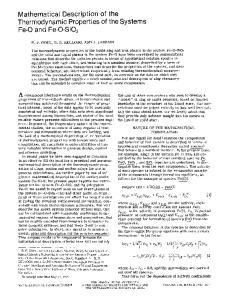Thermodynamic description of Ge-Mn-Si
- PDF / 567,659 Bytes
- 6 Pages / 612 x 792 pts (letter) Page_size
- 7 Downloads / 344 Views
Thermodynamic description of Ge-Mn-Si Alexandre Berche1, Jean-Claude Tédenac1, Philippe Jund1 and Stéphane Gorsse2 ICGM-Université Montpellier II, UMR-CNRS 5253, Pl. E. Bataillon CC1506 Montpellier, 34095, France. 2 ICMCB-Universite de Bordeaux, CNRS Pessac, F-33600, France.
1
ABSTRACT Literature data of the Mn-Si system is analyzed and discordances are pointed out. First principles calculations are performed to clarify the enthalpies of formation of the intermetallic phases. Especially the enthalpies of formation of the various possible structures of the MnSix are discussed. On the basis of these new data, a thermodynamic description of the Gibbs energy of the phases is performed using the Calphad method. The system Ge-Mn is also assessed using the Calphad method for the first time. The mixing enthalpy in the D88 solid solution is calculated between Mn5Ge3 and Mn5Si3 by DFT calculations. Finally a thermodynamic description of the ternary system is suggested. Especially the solubility of germanium in MnSix is modeled. INTRODUCTION Traditional technologies of power generation, process industries (metallurgy, glass, chemicals) and transport are responsible of an enormous amount of waste heat dissipated into the environment. This waste heat may be used for generating electricity by means of “green” thermoelectric generators using the Seebeck effect. For that, if a gradient of temperature is applied to a N-P semiconductor junction, an electrical current is generated. This current is proportional to a figure-of-merit known as ZT. Among the potential materials for thermoelectric applications, Higher Manganese Silicides (HMS) MnSix (with x around 1.75) exhibit interesting figures-of-merit at intermediate temperatures (573K to 873K). Moreover it appears that the figure-of-merit can be improved by germanium doping [1]. The optimization of the elaboration of such alloys needs the knowledge of the ternary Ge-Mn-Si system and of its constitutive binaries. For that, the enthalpy of formation of each phase of the Mn-Si system is calculated by DFT. Moreover, the nature of the HMS phase (single or several phases) is checked by thermal analyses means. Using these elements, the Mn-Si system is assessed using the Calphad method. For the first time the Ge-Mn system is also assessed with the same method. Finally on the basis of DFT calculation, a thermodynamic description of the ternary system Ge-Mn-Si is suggested. THEORY AND EXPERIMENTS
In this work, three different procedures were employed: the theoretical with Differential Fuctional Theory (DFT), the experimental with Differential Thermal Analysis (DTA) and the Calphad method for modeling phase diagram. Such methods are very classical and only the specific points are detailed in this part. The DFT calculations are performed using the Vienna ab initio simulation package (VASP) [2-3] using the projector augmented waves (PAW) technique within the generalized gradient approximation (GGA). The Perdew-Burke-Ernzerhof parameterization (PBE) is applied. Standard versions of the PAW pote
Data Loading...











